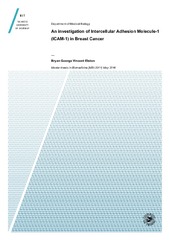| dc.contributor.advisor | Fenton, Kristin | |
| dc.contributor.author | Elston, Bryan George Vincent | |
| dc.date.accessioned | 2016-06-21T09:03:51Z | |
| dc.date.available | 2016-06-21T09:03:51Z | |
| dc.date.issued | 2016-05-18 | |
| dc.description.abstract | Intercellular Adhesion Molecule-1 (ICAM-1, CD54), a cell surface glycoprotein that functions as an integrin, has a well-established role in leukocyte migration during inflammation. Recent studies have indicated a role for this protein in cancer development. In this study three breast cancer cell lines were stimulated with a variety of cytokines. The breast cancer cell lines (MCF7, SK-BR-3 and MDA-MB-468) were chosen to reflect the hormone positive, HER-2 enriched and triple negative subtypes of breast cancer. The cytokines (Interferon gamma, Tumour Necrosis Factor alpha, Interleukin 1beta and Interferon alpha) are commonly encountered in the breast cancer micro-environment. Relative gene expression was measured using quantitative real time polymerase chain reaction. ICAM-1 protein was measured by Western Blot and localised by Immunofluorescence. In addition, ICAM-1 gene expression was measured in human breast cancer samples and ICAM-1 and macrophage (CD68) immunohistochemistry was performed on formalin-fixed, paraffin embedded tumour tissue.
ICAM-1 expression was induced in all of the cell lines by IFN, TNF and IL-1 with increased ICAM-1 protein production compared to time-matched controls. IFN appeared to induce ICAM-1 gene expression but no protein was detected. Membranous and para-nuclear ICAM-1 staining was identified after 24 hours in unstimulated MCF7 and MDA-MB-468 cells and the same cell lines stimulated with IFN. ICAM-1 expression was increased in the human tumour tissue compared to normal tissue however this did not correspond with ICAM-1 positivity or numbers of macrophages in the tumour.
The study highlights a mechanism that cancer cells may use to enhance their invasive and metastatic potential by making use of a protein normally involved in cell migration. | en_US |
| dc.identifier.uri | https://hdl.handle.net/10037/9326 | |
| dc.identifier.urn | URN:NBN:no-uit_munin_8892 | |
| dc.language.iso | eng | en_US |
| dc.publisher | UiT Norges arktiske universitet | en_US |
| dc.publisher | UiT The Arctic University of Norway | en_US |
| dc.rights.accessRights | openAccess | |
| dc.rights.holder | Copyright 2016 The Author(s) | |
| dc.rights.uri | https://creativecommons.org/licenses/by-nc-sa/3.0 | en_US |
| dc.rights | Attribution-NonCommercial-ShareAlike 3.0 Unported (CC BY-NC-SA 3.0) | en_US |
| dc.subject.courseID | MBI-3911 | |
| dc.subject | ICAM-1 | en_US |
| dc.subject | Breast Cancer | en_US |
| dc.subject | cell culture | en_US |
| dc.subject | qPCR | en_US |
| dc.subject | immunohistochemistry | en_US |
| dc.subject | immunofluorescence | en_US |
| dc.subject | VDP::Medisinske Fag: 700::Basale medisinske, odontologiske og veterinærmedisinske fag: 710::Medisinsk immunologi: 716 | en_US |
| dc.subject | VDP::Medical disciplines: 700::Basic medical, dental and veterinary science disciplines: 710::Medical immunology: 716 | en_US |
| dc.title | An investigation of Intercellular Adhesion Molecule-1 (ICAM-1) in Breast Cncer | en_US |
| dc.type | Master thesis | en_US |
| dc.type | Mastergradsoppgave | en_US |


 English
English norsk
norsk
